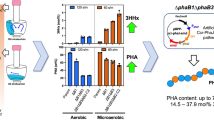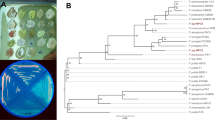Abstract
Pseudomonas aeruginosa are ubiquitous γ-proteobacteria capable of producing the biosurfactant rhamnolipids (RL) and the polymer polyhydroxyalkanoate (PHA). RL are glycolipids with high biotechnological potential, whereas PHA is used for the production of biodegradable plastics. It has been proposed that the β-oxidation pathway provides intermediates for RL biosynthesis, even when using a non-fatty acid carbon source for growth, while an intermediate of de novo fatty acid biosynthesis (FASII) pathway [(R)-3-hydroxyacyl-ACP] is used for PHA biosynthesis. The aim of this work is to study the inter-relationship of the RL and PHA biosynthetic pathways in a culture medium with a non-fatty acid carbon source, focusing on the role of FASII and β-oxidation in supplying the substrates for the first step in RL and PHA synthesis, carried out by the RhlA and PhaG enzymes, respectively. The PHA synthases (PhaC1 and PhaC2) are only able to use CoA-linked 3-hydroxy acids and the PhaG enzyme catalyzes the conversion of (R)-3-hydroxyacyl-ACP to (R)-3-hydroxyacyl-CoA, the substrate of PhaC1 and PhaC2. RhlA in turn catalyzes the synthesis of the RL precursor 3-(3-hydroxyalkanoyloxy) alkanoic acids (HAA) by the dimerization of two 3-hydroxyalkanoic acid molecules (that have been shown to be also (R)-3-hydroxyacyl-ACP). In this work, we show that RhlA can produce both RL and PHA precursors (presumably CoA-linked HAA), that the blockage of carbon flux through β-oxidation pathway does not decrease RL titer, and that the enoyl-CoA hydratase RhlY and enoyl-CoA hydratase/isomerase RhlZ produce the main fatty acids precursor of RL using as substrate also a FASII intermediate (presumably (S)-3-hydroxyacyl-CoA).





Similar content being viewed by others
References
Abbes I, Rihouey C, Hardouin J, Jouenne T, De E, Alexandre S (2018) Identification by mass spectrometry of glucosaminyl-phosphatidylglycerol, a phosphatidylglycerol derivative, produced by Pseudomonas aeruginosa. Rapid Commun Mass Spectrom 32:2113–2121. https://doi.org/10.1002/rcm.8277
Abdel-Mawgoud AM, Lépine F, Déziel E (2014) A stereospecific pathway diverts β-oxidation intermediates to the biosynthesis of rhamnolipid biosurfactants. Chem Biol 21(1):156–164
Chandrasekaran EV, Bemiller JN (1980) Constituent analysis of glycosamynoglycans. Methods Carbohydr Chem 8:89–96
Chen G-Q, Hajnal I, Wu H, Lv L, Ye J (2015) Engineering biosynthesis mechanisms for diversifying polyhydroxyalkanoates. Trends Biotecnol 33(10):565–574
Choi MH, Xu J, Gutierrez M, Yoo T, Cho YH, Yoon SC (2011) Metabolic relationship between polyhydroxyalkanoic acid and rhamnolipid synthesis in Pseudomonas aeruginosa: comparative 13C NMR analysis of the products in wild-type and mutants. J Bacteriol 151:30–42
Eggink G, De Ward P, Huijberts GNM (1992) The role of fatty acid biosynthesis and degradation in the supply of substrates for poly(3-hydroxy-alkanoate) formation in Pseudomonas putida. FEMS Microbiol Rev 103:159–164
Filloux A, Ramos J-L (eds) (2014) Pseudomonas methods and protocols. Methods in molecular biology 1149. Springer Protocols, Humana Press, New York
Grosso-Becerra MV, González-Valdez A, Granados-Martínez MJ, Morales E, Servín-González L, Méndez JL, Delgado G, Morales-Espinosa R, Ponce-Soto GY, Cocotl-Yañez M, Soberón-Chávez G (2016) Pseudomonas aeruginosa ATCC 9027 is a non-virulent strain suitable for mono-rhamnolipids production. Appl Microbiol Biotechnol 100:9995–10004
Gutiérrez-Gómez U, Soto-Aceves MP, Servín-González L, Soberón-Chávez G (2018) Overproduction of rhamnolipids in Pseudomonas aeruginosa PA14 by redirection of the carbon flux from polyhydroxyalkanoate synthesis and overexpression of the rhlAB-R operon. Biotechnol Lett 40:1561–1566. https://doi.org/10.1007/s10529-018-2610-8
Hoang TT, Karkhoff-Schweizer RR, Kutchma AJ, Schweizer HP (1998) A broad-host-range Flp-FRT recombination system for site-specific excision of cromosomally-located DNA sequences: application for isolation of unmarked Pseudomonas aeruginosa mutants. Gene 212:77–86
Kang Y, Zarzycki-Siek J, Walton CB, Norris MH, Hoang TT (2010) Multiple FadD acyl-CoA synthetases contribute to differential fatty acid degradation and virulence in Pseudomonas aeruginosa. PLoS One 5(10):e13557
Langenbach S, Rehm BHA, Steinbüchel A (1997) Functional expression of the PHA synthase gene phaC1 from Pseudomonas aeruginosa in Escherichia coli results in poly(3-hydroxyalkanoate) synthesis. FEMS Microbiol Lett 150:303–309
Lesic B, Rahme LG (2008) Use of the lambda Red recombinase system to rapidly generate mutants in Pseudomonas aeruginosa. BMC Mol Biol 9:20–28
Pech-Canul Á, Nogales J, Miranda-Molina A, Álvarez L, Geiger O, Soto MJ, López-Lara IM (2011) FadD is required for utilization of endogenous fatty acid released from membrane lipids. J Bacteriol 193(22):6295–6304
Rehm BHA, Niels K, Steinbüchel A (1998) A new metabolic link between fatty acid de novo biosynthesis and polyhydroxyalkanoic acid synthesis: the phaG gene from Pseudomonas putida KT2440 encodes a 3-hydroxyacyl-acyl carrier protein-coenzyme A transferase. J Biol Chem 273(37):24044–24051
Sambrook J, Fritsch EF, Maniatis T (1989) Molecular cloning: a laboratory manual, 2nd. edn. Cold Spring Harbor Lab Press, Cold Spring Harbor
Soberón-Chávez G, Lépine F, Déziel E (2005) Production of rhamnolipids by Pseudomonas aeruginosa. Appl Microbiol Biotechnol 68:718–725
Timm A, Steinbüchel A (1992) Cloning and molecular analysis of the poly(3-hydroxyalkanoic acid) gene locus of Pseudomonas aeruginosa PAO1. Eur J Biochem 209:15–30
Vijay R, Tarika K (2018) Production of polyhydroxyalkanoates (PHA) using synthetic biology and metabolic engineering approaches. Res J Biotech 13(1):99–109
Williams P, Cámara M (2009) Quorum sensing and environmental adaptation in Pseudomonas aeruginosa: a tale of regulatory networks and multifunctional signal molecules. Curr Opin Microbiol 12:182–191
Wittgens A, Kovacic F, Müller MM, Gerlitzki M, Santiago-Schübel B, Hofmann D, Tiso T, Blank LM, Henkel M, Hausmann R, Syldatk C, Wilhelm S, Rosenau F (2017) Novel insights into biosynthesis and uptake of rhamnolipids and their precursors. Appl Microbiol Biotechnol 101(7):2865–2878
Zhang Y, Miller RM (1992) Enhanced octadecane dispersion and biodegradation by a Pseudomonas rhamnolipid surfactant (biosurfactant). Appl Environ Microbiol 58:3276–3282
Zhu K, Rock CO (2008) RhlA converts β-hydroxyacyl-acyl carrier protein intermediates in fatty acid synthesis to the β-hydroxydecanoyl-β-hydroxydecanoate component of rhamnolipids in Pseudomonas aeruginosa. J Bacteriol 190(9):3147–3154
Funding
UGG is a doctoral student of Programa de Maestría y Doctorado en Ciencias Bioquímicas, Universidad Nacional Autónoma de México (UNAM), and this article was performed in partial fulfillment of the requirements for UGG doctorate degree. UGG (CVU-422007) received a fellowship from CONACYT. This work was supported in part by grant IN201819 from Programa de Apoyo a Proyectos de Investigación e Innovación Tecnológica, (Dirección General de Asuntos del Personal Académico-UNAM) and grant 252269 from Consejo Nacional de Ciencia y Tecnología (CONACYT).
Author information
Authors and Affiliations
Corresponding author
Ethics declarations
Conflict of interest
The authors declare that they have no conflict of interest.
Ethical statement
This work was performed following the “Código Ético para el Personal Académico del Instituto de Investigaciones Biomédicas, UNAM” (Ethical Manual of the Biomedical Research Institute, UNAM).
Additional information
Publisher’s note
Springer Nature remains neutral with regard to jurisdictional claims in published maps and institutional affiliations.
Electronic supplementary material
ESM 1
(PDF 202 kb)
Rights and permissions
About this article
Cite this article
Gutiérrez-Gómez, U., Servín-González, L. & Soberón-Chávez, G. Role of β-oxidation and de novo fatty acid synthesis in the production of rhamnolipids and polyhydroxyalkanoates by Pseudomonas aeruginosa. Appl Microbiol Biotechnol 103, 3753–3760 (2019). https://doi.org/10.1007/s00253-019-09734-x
Received:
Accepted:
Published:
Issue Date:
DOI: https://doi.org/10.1007/s00253-019-09734-x




